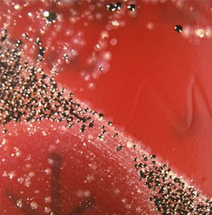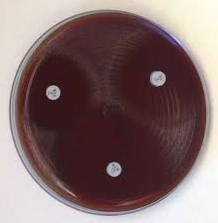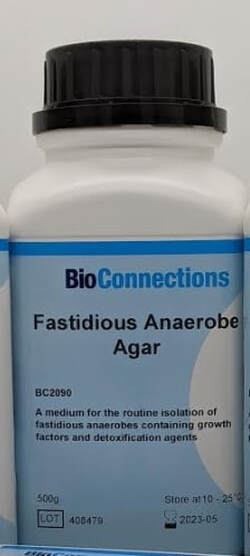Fastidious Anaerobe Agar (F.A.A.)
|
For isolation
This product has strong historical links with BioConnections.
Now the medium of choice for the routine isolation of clinically significant anaerobes, our medium supports the growth of most fastidious anaerobes. Classical colony formation, odour and fluorescence under UV are diagnostic features on this medium. The choice of peptones and growth factors provide early growth of most organisms whilst the starch has an important role as a de-toxification agent. The medium is often made selective for various groups of anaerobes by the addition of appropriate selective agents. |
For susceptibility testing
At ECCMID 2018 a poster was presented outlining the work towards the development of a EUCAST disk diffusion method for rapidly growing anaerobic bacteria using fastidious anaerobe agar (FAA).
'Conclusion: FAA is a reliable medium for disk diffusion of anaerobic bacteria when using agar from at least three manufacturers.' BioConnections is one of those manufacturers Link to poster abstract other items on FAA and susceptibility testing in the ESCMID elibrary include; Link to 'clinical Bacteroides fragilis & FAA' Link to anaerobes-susceptibility-FAA presentation |
PRODUCT AVAILABILITY
Fastidious Anaerobe Agar is available from BioConnections in 500 grams amounts code BC2090R LINK
We also ship in 2.5 kilo amounts direct to manufacturers of ready to use media in the UK and throughout Europe..
code BC2090w2.5
Fastidious Anaerobe Agar is available from BioConnections in 500 grams amounts code BC2090R LINK
We also ship in 2.5 kilo amounts direct to manufacturers of ready to use media in the UK and throughout Europe..
code BC2090w2.5
BioConnections Fastidious Anaerobe Agar has been quoted in many references since 1995 - the following are just a few examples;
Principles and Practice of Clinical Bacteriology 2006 - page 580
Use of Quantitative PCR and Culture Methods To Characterise Ecological Flux in Bacterial Biofilms https://jcm.asm.org/content/45/9/3072
Bordetella petrii Clinical Isolate https://wwwnc.cdc.gov/eid/article/11/7/05-0046_article
Molecular identification of bacteria associated with canine periodontal disease http://www.uesc.br/cursos/pos_graduacao/mestrado/animal/pdf_10.pdf
Evidence of an in-vitro Coupled Diffusion Mechanism of Lesion Formation within Microcosm Dental Plaque Caries Res 2017;51:188-197
Comparison of the efficacy of ramoplanin and vancomycin in both in vitro and in vivo models of clindamycin-induced Clostridium difficile infection https://academic.oup.com/jac/article/56/4/717/769503
Principles and Practice of Clinical Bacteriology 2006 - page 580
Use of Quantitative PCR and Culture Methods To Characterise Ecological Flux in Bacterial Biofilms https://jcm.asm.org/content/45/9/3072
Bordetella petrii Clinical Isolate https://wwwnc.cdc.gov/eid/article/11/7/05-0046_article
Molecular identification of bacteria associated with canine periodontal disease http://www.uesc.br/cursos/pos_graduacao/mestrado/animal/pdf_10.pdf
Evidence of an in-vitro Coupled Diffusion Mechanism of Lesion Formation within Microcosm Dental Plaque Caries Res 2017;51:188-197
Comparison of the efficacy of ramoplanin and vancomycin in both in vitro and in vivo models of clindamycin-induced Clostridium difficile infection https://academic.oup.com/jac/article/56/4/717/769503
|
|
|




